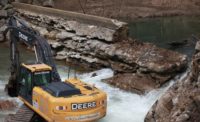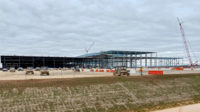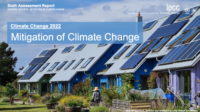The window of opportunity to pursue climate-resilient development is “rapidly narrowing” and will only become more difficult as global temperatures rise, says the United Nations’ Intergovernmental Panel on Climate Change.
In a report released Feb. 28, the UN panel warns that human-induced climate change is putting billions of people around the world at risk of weather extremes. Communities on coasts, small islands, deserts, mountains and polar regions are at particular risk, as are those already facing economic inequities. Some findings were already known, but the report adds new detail about the problem and efforts to solve it.
If the global temperature increases 1.5°C (2.7°F) compared to pre-industrial levels, some climate hazards will be unavoidable and irreversible, the report states. A previous panel climate report found that human-induced warming had reached about 1°C as of 2017. Every increment of warming will add more constraints on adaptation efforts.
“This report is a dire warning about the consequences of inaction,” Hoesung Lee, panel chair, said in a statement. “It shows that climate change is a grave and mounting threat to our wellbeing and a healthy planet. Our actions today will shape how people adapt and nature responds to increasing climate risks.”
The report was prepared by a working group of 270 scientists from 67 countries. It examines current impacts of climate change and projects future risks, as well as ways to strengthen resilience to climate change.
Resilient development pathways will be especially constrained if global temperatures do reach the 1.5-degree threshold, but there are still ways for governments and the private sector to pursue resiliency for now, the report states. Those developments will require choices that prioritize risk reduction, as well as equity and justice.
Responding to the report's findings, environmental policy and action nonprofit The Center for Climate and Energy Solutions said in a statement that adaptation efforts must be ramped up dramatically as humanity struggles with more intense storms, wildfires, floods and heatwaves associated with climate change.
“We cannot restore enough wetlands, build ever-higher levees, pop-up ever-greater numbers of summer cooling stations, or douse every wildfire we see today – let alone address the needs of a future in which we continually neglect the source of those super-charged disasters,” the group said.
The UN has projected that 2.5 billion more people will be living in urban areas by 2050. Continued urban growth means there are opportunities to integrate adaptation strategies when building or upgrading infrastructure, or building new urban places. Strategies may include a combination of hard- and soft-protection such as sea walls and coastal wetlands, accommodations like elevating houses, dis-incentivizing development in high-risk areas, addressing social vulnerabilities and moving development further inland, the report states.
“Together, growing urbanization and climate change create complex risks, especially for those cities that already experience poorly planned urban growth, high levels of poverty and unemployment and a lack of basic services,” Debra Roberts, co-chair of the working group behind the report, said in a statement. “But cities also provide opportunities for climate action – green buildings, reliable supplies of clean water and renewable energy and sustainable transport systems that connect urban and rural areas can all lead to a more inclusive, fairer society.”
Development of resilient infrastructure must include long-term planning, the UN panel says. In some cases, poor or insufficient planning has led to "maladaptive" infrastructure that cannot be easily or affordably adjusted and have had unintended negative environmental impacts.
Moreover, resilient infrastructure should strengthen, not weaken, natural systems, report authors assert.
Hans-Otto Pörtner, Roberts' co-chair, said that restoring degraded ecosystems and conserving 30 to 50% of Earth’s habitats will benefit society by allowing nature to absorb and store carbon. Some traditional strategies for dealing with climate change impacts, such as sea walls to protect eroding coastlines, can be overwhelmed by extreme weather and fail, the report notes. But on a natural coast, protective vegetation will gradually move inland with the changing shoreline and still protect against catastrophic flooding.
In North America, coastal areas will be at risk from sea level rise, hurricanes and other severe storms even if warming is limited to 1.5°C, the report states. Coastal, riverine and urban flooding will likely displace people from urban centers. Flooding will also impact transportation and trade.
Large wildfires are also expected to increasingly endanger people in North America and impact their jobs, health, property, infrastructure and economic activities, according to the report. Those wildfires will also impact air and municipal water quality, adding more health complications.
U.S. Sen. Tom Carper, (D), chair of the Senate Committee on Environment and Public Works, said in a statement that the report makes it clear that the U.S. must adapt in response to climate change.
He touted the SHORRE Act, a bill recently introduced by a bipartisan group of lawmakers that would authorize the U.S. Army Corps of Engineers to overhaul the way it develops projects designed to defend against flooding and coastal storms, including promoting nature-based resilience projects.






Post a comment to this article
Report Abusive Comment